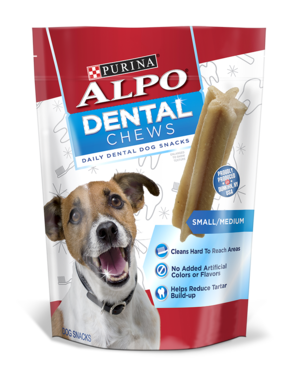Alpo Dental Chews Small/Medium Review
PawDiet has been helping pet owners since 2015. To fund our efforts, articles may include affiliate links; if you buy something through a link, we may earn a commission.
Review of Alpo Dental Chews Small/Medium
According to our most recent data, this product is intended for intermittent or supplemental feeding only.
Review of Ingredients
In our review of Alpo Dental Chews Small/Medium, we'll examine all 16 ingredients and highlight the nutritional contribution of each ingredient.
While the first few ingredients typically dominate the recipe's composition, ingredients in small quantities can still have a meaningful impact on the overall nutritional profile of the recipe.
Rice is a carbohydrate source that is easy to digest and provides quick energy for dogs. It can also serve as a dietary fiber, supporting gut health.
Water sufficient for processing is a necessary component in wet dog food recipes. It provides the required moisture to create a palatable texture and consistency, making it easier for your pet to consume and digest their food.
Glycerin is a natural ingredient used as a humectant to help maintain the moisture content of dog food, keeping it fresh and palatable.
Gelatin is a natural source of collagen, which helps maintain healthy joints and promotes a shiny, healthy coat for your dog.
Chicken by-product meal is a concentrated source of protein that provides essential amino acids for your dog's growth, maintenance, and immune system support. It's made from the clean parts of the chicken, such as the neck, feet, and viscera, which are rich in nutrients.
Dried yeast is a nutrient-rich ingredient that provides essential B vitamins, minerals, and amino acids. It supports a healthy immune system, promotes skin and coat health, and aids in maintaining overall well-being in your dog.
Tricalcium phosphate is used as a calcium supplement in dog foods, contributing to strong teeth and bones.
Carrageenan is a natural thickening agent derived from seaweed that helps improve the texture and consistency of your dog's food.
Phosphoric acid is used in dog food as a pH stabilizer and a preservative, helping to maintain the freshness and quality of the product. It also aids in the absorption of essential minerals, promoting the overall health of your pet.
Partially hydrogenated vegetable oil is a source of dietary fat which provides energy, although it should be consumed in moderation due to potential health concerns.
Sorbic acid is a food-grade preservative used to maintain freshness and extend shelf life in dog food. It is generally recognized as safe for consumption in small amounts.
Calcium Propionate is a commonly used preservative in dog food to inhibit the growth of molds and bacteria, keeping the food fresh and safe for longer periods.
Though often controversial due to potential health concerns, BHA (Butylated Hydroxyanisole) is an antioxidant that is sometimes used in dog food to preserve fats and reduce food spoilage.
BHT (butylated hydroxytoluene) is a synthetic antioxidant used as a preservative in some dog foods to maintain freshness and extend shelf life. While controversial, it is approved for use in pet foods in regulated amounts.
Calcium carbonate is a valuable source of calcium, an essential mineral for strong bones and teeth, and for supporting proper muscle function in your dog.
Citric acid is a natural preservative that helps maintain the freshness and quality of dog food. It also acts as an antioxidant, which can help protect your dog's cells from damage caused by free radicals.
Review of Guaranteed Analysis
Crude Protein (min) of 7.00%: The crude protein content in Alpo Dental Chews is at a minimum of 7%. This protein likely comes from the chicken by-product meal, which is a common source of animal protein in pet foods. Chicken by-product meal is made from rendering chicken parts that are not typically consumed by humans. Dried yeast may also contribute to the protein content, as yeast can be a good source of proteins and vitamins.
Crude Fat (min) of 2.00%: The minimum crude fat content of 2% is relatively low, suggesting that these dental chews are not designed to be a high-fat product. The crude fat present is most likely derived from the partially hydrogenated vegetable oil, which is a source of fat, although not necessarily a high-quality one. Chicken by-product meal may also contribute to the fat content to a lesser extent.
Crude Fiber (max) of 2.00%: The crude fiber content is capped at a maximum of 2%, which indicates that these chews are not particularly high in fiber. The primary source of fiber in this product is likely the rice, as it can contain varying amounts of fiber depending on the type and how much it has been processed. Other ingredients, such as carrageenan, may also have some fiber content, but they are typically used in small amounts and are more likely included for their gelling properties rather than as a fiber source.

